Do you have a question about the Toyota 1997 Corolla and is the answer not in the manual?
Explains instrument panel, cluster, and indicator symbols, detailing their functions and locations.
Provides a visual guide to the layout and identification of various controls on the instrument panel.
Details the components and layout of the instrument cluster, including gauges and indicator lights.
Lists and explains the meaning of various warning lights and indicators found on the instrument panel.
Covers the operation and security features of vehicle keys and various door mechanisms.
Explains the master and subkeys, key number plate, and procedures for obtaining duplicate keys.
Details how to lock and unlock side doors using the key, inside lock button, or power door lock switch.
Explains how to operate the driver's and passengers' power windows, including automatic functions.
Provides instructions on how to open and close the trunk lid using the key or release lever.
Describes the operation of the back door lock knob and the child-protector feature for rear doors.
Details the procedure for opening and closing the vehicle hood, including safety precautions.
Explains the vehicle's theft deterrent system, how to set, stop, and reset the alarm.
Instructions on how to open and remove the fuel tank cap, with safety warnings.
Covers seat adjustment, seat belt usage, SRS airbags, child restraints, and mirror adjustments.
Provides seat adjustment precautions and instructions for positioning the seat and seatback.
Explains seat belt precautions, child restraint usage, pregnant women, and injured persons.
Details the function, operation, and safety precautions related to the Supplemental Restraint System (SRS) airbags.
Provides guidance on the proper use and installation of child restraint systems for child safety.
Explains how to adjust the steering wheel angle, with safety precautions.
Covers adjustment of outside rear view mirrors and the anti-glare inside rear view mirror.
Describes the vehicle's gauges, meters, service reminder indicators, and warning buzzers.
Explains the fuel gauge operation, low fuel warning light, and when to fill the tank.
Details the engine coolant temperature gauge and what to do if the engine overheats.
Explains the tachometer's function for monitoring engine speed and selecting gears.
Describes the odometer for total distance and the trip meter for recording trip distances.
Lists and explains the function of various service reminder indicators and warning buzzers.
Covers ignition switch operation, automatic and manual transmissions, parking brake, and cruise control.
Explains the ignition switch positions, steering lock mechanism, and starting the engine.
Details the operation of the automatic transmission, including shift patterns and driving modes.
Instructions on how to set and release the parking brake, with safety precautions.
Explains how to operate the cruise control system, set speed, and cancel settings.
Covers the operation and controls for the car audio system and the air conditioning system.
Details the basic features, controls, and operating tips for the car audio system.
Explains the controls for the air conditioning system, including fan speed, temperature, and air flow.
Describes various other equipment in the vehicle, such as the clock, lighter, and glove box.
Instructions on how to set and reset the digital clock.
Explains the operation of the cigarette lighter and the use and cleaning of the ashtray.
Instructions on how to open the glove box door and safety precautions.
Details on how to use the cup holder and safety precautions for its use.
Guidance on using the correct size floor mat and ensuring proper placement for safety.
Provides tips for the initial break-in period to ensure vehicle economy and longevity.
Details the correct fuel type, octane number, and precautions for using gasoline.
Advice on complying with local laws and confirming fuel availability when driving abroad.
Explains the function of the catalytic converter and safety precautions related to exhaust.
Highlights safety precautions regarding engine exhaust, including carbon monoxide hazards.
Discusses normal engine oil consumption, its causes, and how to check the oil level accurately.
Covers the tandem master cylinder brake system, brake booster, and anti-lock brake system (ABS).
Explains how to identify worn brake pads by the warning noise they produce.
Provides guidance on securely loading luggage for optimal vehicle balance and safety.
Explains the vehicle identification number (VIN) and its location for legal identification.
Describes the purpose and integrity of theft prevention labels affixed to the vehicle.
Warns against modifying the suspension or chassis, which can affect handling and control.
Differentiates between summer, all-season tires, and provides caution on mixing tire types.
A pre-drive checklist covering vehicle inspection, seat, mirrors, doors, and seat belts.
Step-by-step instructions for starting the engine with manual and automatic transmissions.
Advice for safe driving in adverse conditions like gusty winds, curbs, and wet roads.
Guidance on preparing the vehicle for winter, including antifreeze, battery, and locks.
Covers trailer towing considerations, weight limits, hitches, safety chains, and trailer lights.
Tips on improving fuel economy and vehicle longevity through proper driving and maintenance habits.
Troubleshooting steps for when the engine won't start, including battery checks and jump starting.
Procedure to follow if the engine stalls while driving, including safety actions and restarting.
Steps to take if the engine overheats, including safety checks and coolant management.
Instructions for safely changing a flat tire, including jacking procedures and spare tire use.
Guidance on proper towing procedures and precautions to avoid vehicle damage.
Explains how to use the shift lock override button to shift out of 'P' position.
Information on obtaining replacement keys and procedures for opening the vehicle if keys are locked inside.
Common causes of corrosion and guidelines for preventing it through regular cleaning and maintenance.
Instructions for washing and waxing the vehicle's exterior, including safety precautions.
Guidance on cleaning the vehicle's interior, including upholstery, carpets, and windows.
Overview of vehicle maintenance, emphasizing owner responsibility for general and scheduled upkeep.
Lists regular checks for outside and inside the vehicle to ensure proper operation and safety.
Identifies signs and clues that indicate a vehicle may need adjustment or repair.
Introduces do-it-yourself maintenance, covering engine compartment, fuses, precautions, and tools.
Diagrams illustrating the location of key components in the engine compartment.
Shows the location of fuse boxes in the engine compartment and passenger's side kick panel.
Essential safety precautions to observe when performing do-it-yourself maintenance on the vehicle.
Lists necessary parts and tools for common do-it-yourself maintenance tasks.
Provides instructions for checking and maintaining engine oil, coolant, brake fluid, tires, and wheels.
Step-by-step guide on how to check the engine oil level and add oil if necessary.
Instructions for checking the engine coolant level and selecting the correct coolant type.
Guidance on checking the brake fluid level in the reservoir and refilling as needed.
How to check the power steering fluid level and add fluid if it is low.
Explains the importance of proper tire pressure and how to check it accurately.
Instructions on checking tire tread for wear and procedures for replacing tires.
Recommends tire rotation intervals to equalize wear and extend tire life.
Guidance on when to use snow tires or chains and how to install them correctly.
Covers when to replace wheels and precautions for selecting correct replacement wheels.
Specific precautions for handling and maintaining aluminum wheels, including tightening nuts.
Covers maintenance of electrical components, including battery, fuses, and light bulbs.
Provides precautions and emergency measures for checking battery condition and handling electrolyte.
Safety precautions to follow when recharging the vehicle battery, especially regarding hydrogen gas.
Instructions on how to check for blown fuses and replace them correctly.
Guidance on adding washer fluid, including recommendations for cold weather use.
Illustrations and a table showing how to access and replace various vehicle light bulbs.
Provides key dimensions and weight specifications for the vehicle.
Details engine specifications, including model type, bore, stroke, and displacement.
Specifies fuel type, tank capacity, and oil grade recommendations.
Lists various service specifications, including valve clearance, spark plug gap, and fluid capacities.
Provides tire sizes, pressure specifications, and wheel nut torque information.
Lists fuse types, amperage ratings, and the electrical circuits they control.
Informs owners on how to report vehicle safety defects to NHTSA and Toyota.
Explains DOT quality grades for tires: Treadwear, Traction, and Temperature.
Explains instrument panel, cluster, and indicator symbols, detailing their functions and locations.
Provides a visual guide to the layout and identification of various controls on the instrument panel.
Details the components and layout of the instrument cluster, including gauges and indicator lights.
Lists and explains the meaning of various warning lights and indicators found on the instrument panel.
Covers the operation and security features of vehicle keys and various door mechanisms.
Explains the master and subkeys, key number plate, and procedures for obtaining duplicate keys.
Details how to lock and unlock side doors using the key, inside lock button, or power door lock switch.
Explains how to operate the driver's and passengers' power windows, including automatic functions.
Provides instructions on how to open and close the trunk lid using the key or release lever.
Describes the operation of the back door lock knob and the child-protector feature for rear doors.
Details the procedure for opening and closing the vehicle hood, including safety precautions.
Explains the vehicle's theft deterrent system, how to set, stop, and reset the alarm.
Instructions on how to open and remove the fuel tank cap, with safety warnings.
Covers seat adjustment, seat belt usage, SRS airbags, child restraints, and mirror adjustments.
Provides seat adjustment precautions and instructions for positioning the seat and seatback.
Explains seat belt precautions, child restraint usage, pregnant women, and injured persons.
Details the function, operation, and safety precautions related to the Supplemental Restraint System (SRS) airbags.
Provides guidance on the proper use and installation of child restraint systems for child safety.
Explains how to adjust the steering wheel angle, with safety precautions.
Covers adjustment of outside rear view mirrors and the anti-glare inside rear view mirror.
Describes the vehicle's gauges, meters, service reminder indicators, and warning buzzers.
Explains the fuel gauge operation, low fuel warning light, and when to fill the tank.
Details the engine coolant temperature gauge and what to do if the engine overheats.
Explains the tachometer's function for monitoring engine speed and selecting gears.
Describes the odometer for total distance and the trip meter for recording trip distances.
Lists and explains the function of various service reminder indicators and warning buzzers.
Covers ignition switch operation, automatic and manual transmissions, parking brake, and cruise control.
Explains the ignition switch positions, steering lock mechanism, and starting the engine.
Details the operation of the automatic transmission, including shift patterns and driving modes.
Instructions on how to set and release the parking brake, with safety precautions.
Explains how to operate the cruise control system, set speed, and cancel settings.
Covers the operation and controls for the car audio system and the air conditioning system.
Details the basic features, controls, and operating tips for the car audio system.
Explains the controls for the air conditioning system, including fan speed, temperature, and air flow.
Describes various other equipment in the vehicle, such as the clock, lighter, and glove box.
Instructions on how to set and reset the digital clock.
Explains the operation of the cigarette lighter and the use and cleaning of the ashtray.
Instructions on how to open the glove box door and safety precautions.
Details on how to use the cup holder and safety precautions for its use.
Guidance on using the correct size floor mat and ensuring proper placement for safety.
Provides tips for the initial break-in period to ensure vehicle economy and longevity.
Details the correct fuel type, octane number, and precautions for using gasoline.
Advice on complying with local laws and confirming fuel availability when driving abroad.
Explains the function of the catalytic converter and safety precautions related to exhaust.
Highlights safety precautions regarding engine exhaust, including carbon monoxide hazards.
Discusses normal engine oil consumption, its causes, and how to check the oil level accurately.
Covers the tandem master cylinder brake system, brake booster, and anti-lock brake system (ABS).
Explains how to identify worn brake pads by the warning noise they produce.
Provides guidance on securely loading luggage for optimal vehicle balance and safety.
Explains the vehicle identification number (VIN) and its location for legal identification.
Describes the purpose and integrity of theft prevention labels affixed to the vehicle.
Warns against modifying the suspension or chassis, which can affect handling and control.
Differentiates between summer, all-season tires, and provides caution on mixing tire types.
A pre-drive checklist covering vehicle inspection, seat, mirrors, doors, and seat belts.
Step-by-step instructions for starting the engine with manual and automatic transmissions.
Advice for safe driving in adverse conditions like gusty winds, curbs, and wet roads.
Guidance on preparing the vehicle for winter, including antifreeze, battery, and locks.
Covers trailer towing considerations, weight limits, hitches, safety chains, and trailer lights.
Tips on improving fuel economy and vehicle longevity through proper driving and maintenance habits.
Troubleshooting steps for when the engine won't start, including battery checks and jump starting.
Procedure to follow if the engine stalls while driving, including safety actions and restarting.
Steps to take if the engine overheats, including safety checks and coolant management.
Instructions for safely changing a flat tire, including jacking procedures and spare tire use.
Guidance on proper towing procedures and precautions to avoid vehicle damage.
Explains how to use the shift lock override button to shift out of 'P' position.
Information on obtaining replacement keys and procedures for opening the vehicle if keys are locked inside.
Common causes of corrosion and guidelines for preventing it through regular cleaning and maintenance.
Instructions for washing and waxing the vehicle's exterior, including safety precautions.
Guidance on cleaning the vehicle's interior, including upholstery, carpets, and windows.
Overview of vehicle maintenance, emphasizing owner responsibility for general and scheduled upkeep.
Lists regular checks for outside and inside the vehicle to ensure proper operation and safety.
Identifies signs and clues that indicate a vehicle may need adjustment or repair.
Introduces do-it-yourself maintenance, covering engine compartment, fuses, precautions, and tools.
Diagrams illustrating the location of key components in the engine compartment.
Shows the location of fuse boxes in the engine compartment and passenger's side kick panel.
Essential safety precautions to observe when performing do-it-yourself maintenance on the vehicle.
Lists necessary parts and tools for common do-it-yourself maintenance tasks.
Provides instructions for checking and maintaining engine oil, coolant, brake fluid, tires, and wheels.
Step-by-step guide on how to check the engine oil level and add oil if necessary.
Instructions for checking the engine coolant level and selecting the correct coolant type.
Guidance on checking the brake fluid level in the reservoir and refilling as needed.
How to check the power steering fluid level and add fluid if it is low.
Explains the importance of proper tire pressure and how to check it accurately.
Instructions on checking tire tread for wear and procedures for replacing tires.
Recommends tire rotation intervals to equalize wear and extend tire life.
Guidance on when to use snow tires or chains and how to install them correctly.
Covers when to replace wheels and precautions for selecting correct replacement wheels.
Specific precautions for handling and maintaining aluminum wheels, including tightening nuts.
Covers maintenance of electrical components, including battery, fuses, and light bulbs.
Provides precautions and emergency measures for checking battery condition and handling electrolyte.
Safety precautions to follow when recharging the vehicle battery, especially regarding hydrogen gas.
Instructions on how to check for blown fuses and replace them correctly.
Guidance on adding washer fluid, including recommendations for cold weather use.
Illustrations and a table showing how to access and replace various vehicle light bulbs.
Provides key dimensions and weight specifications for the vehicle.
Details engine specifications, including model type, bore, stroke, and displacement.
Specifies fuel type, tank capacity, and oil grade recommendations.
Lists various service specifications, including valve clearance, spark plug gap, and fluid capacities.
Provides tire sizes, pressure specifications, and wheel nut torque information.
Lists fuse types, amperage ratings, and the electrical circuits they control.
Informs owners on how to report vehicle safety defects to NHTSA and Toyota.
Explains DOT quality grades for tires: Treadwear, Traction, and Temperature.
| Brand | Toyota |
|---|---|
| Model | 1997 Corolla |
| Category | Automobile |
| Language | English |
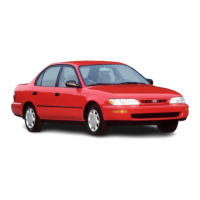

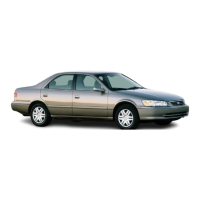

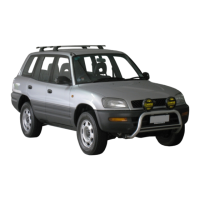
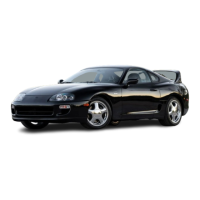
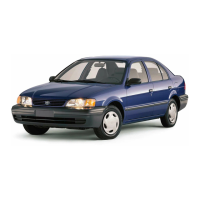
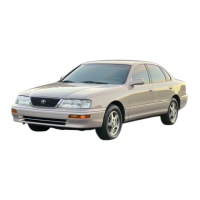
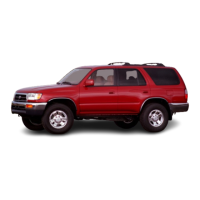
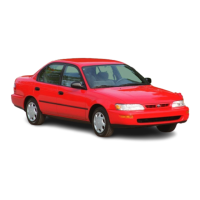

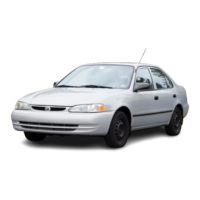
